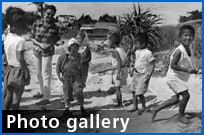With help from American families, a visual history of the island post-WWII is going public
By Chiyomi Sumida, Stars and Stripes
Pacific edition, Saturday, January 26, 2008

|
NANJO, Okinawa — Quonset-hut homes and schools.
Bustling, downtown black-market streets. The bashful smiles of children and landscapes of war-torn Okinawa. These scenes, recorded more than 60 years ago through the camera lenses of the first Americans to remain on Okinawa after World War II, will be on display here in March. Many of the 600 still photographs and 12 rolls of 8 mm film were taken between the mid-1940s and late 1950s, some as early as 1946, when the first group of military dependents and civilian workers came to the island. The exhibition — titled “From the Ashes: Courage and Determination” — will take place March 1-9 at Ozato Noson Kankyo Kaizen Center in Ozato of Nanjo City. The images were donated by 15 American families who lived on Okinawa when the island was struggling to rise from the ashes of World War II, said Shizuo “Alex” Kishaba, chairman of the Ryukyu American Historical Research Society, the exhibition sponsor. “The pictures taken by American people are a precious treasure of Okinawa because hardly any Okinawa people had cameras or 8 mm movie cameras in those days,” he said. Judy Scott of North Carolina was 5 when she, her mother, Martha Holdsworth, and her younger sister, Kathryn, joined her father, Army Maj. Edward Holdsworth, on Okinawa in 1947. Their Quonset home, which was located where Awase Golf Course is now, was primitive and goods were scarce, but the life was full of excitement, Scott wrote in a recent e-mail to Stars and Stripes. “I remember sleeping on an Army cot with mosquito netting around it,” she said, adding that a military jeep occasionally would come by and spray DDT to kill mosquitoes. “It’s a wonder we’re still living!” she joked. She cherishes the memories of her sixth birthday, the day Super Typhoon Libby hit the island and her family was evacuated to a shelter. In the middle of the night, her mother gave her a special present. “My mother was able to find a cupcake from somebody,” Scott said. The shelves at the commissary had limited supplies of food and household supplies, she said. So everyone eagerly awaited the arrival of supply ships from the States. Looking out from a hilltop where their home was, her mother could tell when a ship came in and would rush to the commissary Scott said. Among the photos in the exhibit is a picture of exhausted-looking people disembarking a ship at Naha port after a two-week voyage from Fort Mason in San Francisco. Records show that 27 families arrived aboard the SS David C. Shanks at the Naha port on July 27, 1946. They were the first military dependents. |
|